今回は、軽度~中等度の変形性膝関節症患者に対して、プールでの運動を行い、MRIを用いて軟骨器質成分への効果を検討した論文を紹介します。
前回は軽症の変形性膝関節症患者に対する自転車運動や高強度のマシントレーニングの効果についてについて紹介しました。
変形性膝関節症患者さんに対して、運動は運動機能や疼痛を改善させるといっていいようです。
一方で、変形性膝関節症というのは進行が進むと変形事態を改善させるのは難しくなります。
運動の効果としても、軟骨を再生したり画像所見を改善させたりっているのはなかなか困難です。
それでは、運動を行っても変形性膝関節症に対する画像的な変化というのはないのでしょうか?
軽度~中等度の変形性膝関節症患者に対して、プールでの運動を行い、MRIを用いて軟骨器質成分への効果を検討した論文を紹介します。

今回紹介する研究の概要
今回紹介する論文は、軽度~中等度の変形性膝関節症患者に対して、プールでの運動を行い、MRIを用いて軟骨器質成分への効果を検討した内容になっています。
「Munukka M, Waller B, Rantalainen T, et al. Efficacy of progressive aquatic resistance training for tibiofemoral cartilage in postmenopausal women with mild knee osteoarthritis: a randomised controlled trial. Osteoarthritis Cartilage. 2016 Oct;24(10):1708-1717」、2016年に発行された論文です。
入会金月額料金なし!楽しく続けるなら【オンラインエクササイズLOOOM】対象
Included participants were women aged 60–68 years with mild knee OA. In this study we classify mild knee OA as radiographic changes in tibiofemoral joint grades I (possible osteophytes) or II (definite osteophytes, possible joint space narrowing) according to the Kellgren–Lawrence (K/L) classification and experiencing knee pain on most days. Initially, postmenopausal women from the Jyväskylä region in Central Finland were voluntarily recruited through advertisements in local newspapers. Preliminary eligibility was assessed using a structured telephone interview (n = 323), followed by evaluation of OA severity in the tibiofemoral joint with radiographs (n = 180) and finally through medical screening (n = 111). Inclusion criteria were: postmenopausal woman aged 60–68 years, experiencing knee pain on most days, participates in intensive exercise ≤twice a week, radiographic changes in tibiofemoral joint K/L I or II, no previous cancer or chemotherapy, no medical contraindications or other limitations to full participation in an intensive aquatic training program and complete transverse relaxation time (T2) data. Exclusion criteria included a T-score <−2.5 (indicating osteoporosis)25 measured from the femoral neck using dual-energy X-ray absorptiometry (DXA), resting knee pain visual analogue scale (VAS) >50/100, surgery of the knee due to trauma or knee instability, meniscectomy within the last 12 months, inflammatory joint disease, intra-articular steroid injections in the knee during the previous 12 months, contraindications to MRI and allergies to contrast agents or renal insufficiency. Due to confounding factors related to obesity, a body mass index (BMI) of >34 kg/m2 was an exclusion criterion.
Munukka M, Waller B, Rantalainen T, et al. Efficacy of progressive aquatic resistance training for tibiofemoral cartilage in postmenopausal women with mild knee osteoarthritis: a randomised controlled trial. Osteoarthritis Cartilage. 2016 Oct;24(10):1708-1717
対象は軽度の膝OAを有する60~68歳の女性84名です。
本研究では、Kellgren-Lawrence(K/L)分類による脛骨大腿関節のX線画像変化がグレードI(骨棘の可能性)またはII(明確な骨棘、関節腔狭窄の可能性)で、ほとんどの日に膝痛を感じるものを軽度膝関節症と分類しています。
構造化された電話インタビューで参加資格を評価し(n = 323)、次にX線写真で脛骨大腿関節のOA重症度を評価し(n = 180)、最後にメディカルスクリーニングで参加資格を評価しました(n = 111)。
包含基準は、60-68歳の閉経後女性、ほとんどの日に膝の痛みを感じている、週に2回以下の集中的な運動に参加している、脛骨大腿関節のX線写真の変化 K/L IまたはII、がんや化学療法の既往がない、集中的な水中トレーニングプログラムへの完全参加に禁忌やその他の制限がない、横方向の緩和時間(T2)データが揃っている、でした。
除外基準は、二重エネルギーX線吸収法(DXA)による大腿骨頚部からのTスコア<-2.5(骨粗鬆症を示す)25、安静時膝痛視覚的アナログスケール(VAS)>50/100、外傷または膝の不安定性による膝の手術、過去12ヶ月以内の半月板切除、炎症性関節疾患、過去12ヶ月間の膝への関節内ステロイド注入、MRIへの禁忌、造影剤のアレルギーまたは腎不全などであった。肥満に関する交絡因子のため、BMI(body mass index)34kg/m2超となっています。
入会金月額料金なし!楽しく続けるなら【オンラインエクササイズLOOOM】方法
The participants in the intervention group received 1 h of supervised lower limb aquatic resistance training three times a week for 16 weeks, for a total of 48 training sessions. Resistance of exercises was progressed with three different levels: barefoot, small fins and large resistance boots21 and the training leg performed all the movements without contact with the pool walls or bottom i.e., non-weight bearing. Intensity of the training sessions was set at “as hard and fast as possible” to ensure maximal muscle contraction. Pöyhönen et al.34 discovered that during maximal knee flexion and extension exercises in water with large resistance boots the drag forces produced were 80–85% (145 ± 30 N) of maximal isokinetic movements. Full range of motion was strictly controlled for to ensure optimal movement of synovial fluid and exposure of the whole cartilage to the low compressive and shear forces created by the muscle contraction and movement. Training intensity was monitored using heart rate monitors (Polar Electro Ltd, Kempele, Finland), rate of perceived exertion (RPE) using the Borg 6–20 scale35 and number of repetitions achieved per movement.
Munukka M, Waller B, Rantalainen T, et al. Efficacy of progressive aquatic resistance training for tibiofemoral cartilage in postmenopausal women with mild knee osteoarthritis: a randomised controlled trial. Osteoarthritis Cartilage. 2016 Oct;24(10):1708-1717
介入群の参加者は、週3回、1時間の指導付き下肢水中レジスタンストレーニングを16週間、合計48回のトレーニングセッションを受けました。
トレーニングセッションの強度は、最大筋収縮を確保するために「可能な限り強く、速く」設定されました。
膝の最大屈曲と伸展のエクササイズを行った際、発生する抗力は最大等速運動の80~85%(145±30N)であることを発見されています。
対照群は、通常のケアを維持し、通常の余暇活動を継続するよう求められた。彼らは、4ヶ月の介入期間中に、1時間の軽いストレッチとリラクゼーションからなる2つのセッションに参加する可能性を提供されました。
入会金月額料金なし!楽しく続けるなら【オンラインエクササイズLOOOM】Primary outcomes for this study were T2 relaxation time (T2) mapping (milliseconds, ms) and delayed gadolinium-enhanced magnetic resonance imaging of cartilage (dGEMRIC index, ms). IIn this study we divided the femoral cartilage into three region of interests (ROIs); anterior, central and posterior. Cardiorespiratory fitness (VO2 peak, ml/kg/min) was estimated using the UKK 2 km walking test (UKK Institute, Tampere, Finland)29. Isometric knee extension and flexion force (N) of the affected knee was measured using an adjustable dynamometer chair (Good strength; Metitur Ltd, Jyväskylä, Finland).Self-assessed impact of OA on pain, other symptoms, activities of daily living (ADL), sports and recreation (Sport) and knee related quality of life (QOL) were assessed using the validated Finnish Likert version of the knee injury and osteoarthritis outcome score (KOOS) questionnaire.
Munukka M, Waller B, Rantalainen T, et al. Efficacy of progressive aquatic resistance training for tibiofemoral cartilage in postmenopausal women with mild knee osteoarthritis: a randomised controlled trial. Osteoarthritis Cartilage. 2016 Oct;24(10):1708-1717
本研究の主要結果は、T2緩和時間(T2)マッピングおよび軟骨の遅延ガドリニウム増強磁気共鳴画像(dGEMRIC指数、ms)です。大腿骨軟骨を前部、中央部、後部の3つの関心領域(ROI)に分割して評価しています。
心肺機能(VO2ピーク、ml/kg/min)は、UKK2km歩行テスト(UKK Institute, Tampere, Finland)を使用して測定しました。
患側膝の等尺性伸展・屈曲力(N)は、調節可能なダイナモチェア(Good strength; Metitur Ltd, Jyväskylä, Finland)を使用して測定しました。
疼痛、その他の症状、日常生活動作(ADL)、スポーツ・レクリエーション(Sport)、膝関連のQOLに対するOAによる影響を、KOOS質問票を用いて自己評価しています。
Munukka M, Waller B, Rantalainen T, et al. Efficacy of progressive aquatic resistance training for tibiofemoral cartilage in postmenopausal women with mild knee osteoarthritis: a randomised controlled trial. Osteoarthritis Cartilage. 2016 Oct;24(10):1708-1717
私も詳細は理解できていませんが、MRIによる画像評価によって膝関節軟骨内のグリコサミノグリカンや水分量など軟骨基質成分の評価が可能なようです。
つまり、運動によって画像的な変化も出現するのかを評価しているようですね。
入会金月額料金なし!楽しく続けるなら【オンラインエクササイズLOOOM】結果
Munukka M, Waller B, Rantalainen T, et al. Efficacy of progressive aquatic resistance training for tibiofemoral cartilage in postmenopausal women with mild knee osteoarthritis: a randomised controlled trial. Osteoarthritis Cartilage. 2016 Oct;24(10):1708-1717
こちらは4ヵ月間の介入終了時のT2およびdGEMRIC indexのベースライン値、変化、群間差、効果量になります。
大腿骨内側軟骨の後方全層において、トレーニング群では対照群と比較してT2、dGEMRIC index 共に有意の減少を認めました。
さらに、トレーニング群では、T2およびdGEMRIC indexについて、それぞれ-1.6 ms(-3.0→-0.3, P = 0.016)、-26 ms(-50→-3, P = 0.030)、対照群と比較して、大腿骨中部軟骨の表面ではなく後面の深いROIでのみ有意な低下が見られました.
難しい話ですが、運動を行うとMRIで画像的に良い変化が認められたとのことですね。
Munukka M, Waller B, Rantalainen T, et al. Efficacy of progressive aquatic resistance training for tibiofemoral cartilage in postmenopausal women with mild knee osteoarthritis: a randomised controlled trial. Osteoarthritis Cartilage. 2016 Oct;24(10):1708-1717
こちらは介入前後の運動機能や自己評価の変化です。
心肺機能のVO2ピークはトレーニング群で9.8%、コントロール群で4.4%増加した(d = 0.58, P = 0.010)。膝伸展筋力、膝屈曲筋力、KOOSのどの領域にも群間差はありませんでした。
入会金月額料金なし!楽しく続けるなら【オンラインエクササイズLOOOM】結論
Our results suggest that, in postmenopausal women with mild knee OA, the integrity of the collagen-interstitial water environment (T2) of the tibiofemoral cartilage may be responsive to low shear and compressive forces during aquatic resistance training. Further research is required to understand the exact nature of acute responses in dGEMRIC index to this type of loading. Clinical relevance of our findings remains unclear but strongly warrants further research. Additionally, aquatic resistance training of sufficient intensity to improve cardiorespiratory function is well tolerated, has high compliance and low risk of harm amongst women with mild knee OA.
Munukka M, Waller B, Rantalainen T, et al. Efficacy of progressive aquatic resistance training for tibiofemoral cartilage in postmenopausal women with mild knee osteoarthritis: a randomised controlled trial. Osteoarthritis Cartilage. 2016 Oct;24(10):1708-1717
この結果は、軽度の膝関節症を有する閉経後女性において、脛骨大腿軟骨のコラーゲン-間質水環境(T2)の完全性が、水中レジスタンストレーニング中の低せん断力および圧縮力に反応する可能性を示唆するものです。
さらに、心肺機能を改善するのに十分な強度の水中レジスタンストレーニングは、軽度の膝関節OAの女性において、忍容性が高く、コンプライアンスが高く、有害性のリスクが低い。
水中での運動が、膝関節の関節軟骨器質成分に好影響の可能性があり、心肺機能を高めるためにも効果的かもしれないというのは素晴らしい結果ですね。
陸上でのウォーキングよりも水中での運動負荷の方が膝の負担が少ないのは予想していましたが、膝関節の状態を改善させる可能性があるとまでは思っていませんでした。
自転車運動に引き続き、水中ウォーキングなども、膝痛があるがん患者さんも検討していいようですね。
入会金月額料金なし!楽しく続けるなら【オンラインエクササイズLOOOM】・介入群の参加者は、週3回、1時間の指導付き下肢水中レジスタンストレーニングを16週間、合計48回のトレーニングセッションを受けた。
・大腿骨内側軟骨の後方全層において、トレーニング群では対照群と比較してT2、dGEMRIC index 共に有意の減少を認めた。
・水中での運動が、膝関節の関節軟骨器質成分に好影響の可能性があり、心肺機能を高めるためにも効果的かもしれない。
・自転車運動に引き続き、水中ウォーキングなども、膝痛があるがん患者さんも検討していいようである。
このブログは、ガイドラインや論文などの根拠をもとに情報を発信していく予定です。
しかし、がんの病態や治療方法によっては、お読みになっているがん患者さんにはその情報が当てはまらない場合もあります。
記事の内容を参考に新しく何かを始める場合には、担当の医師や医療従事者にご確認いただくようお願いいたします。

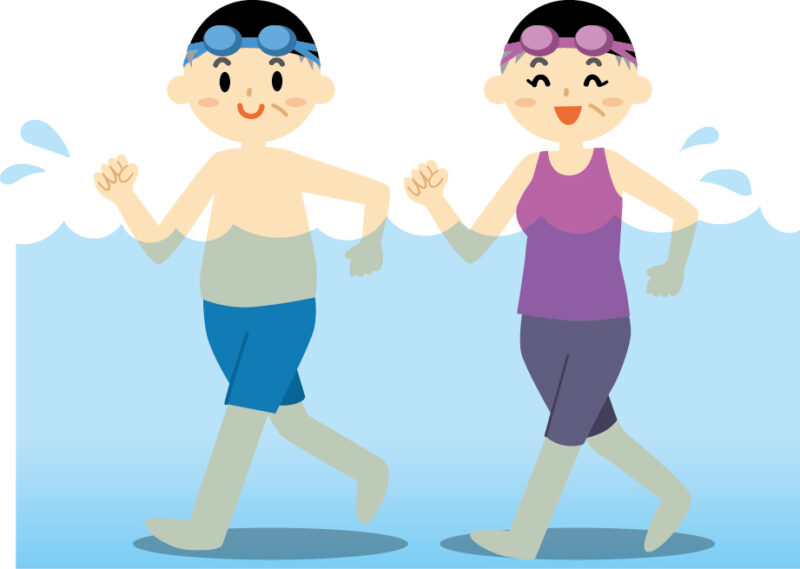

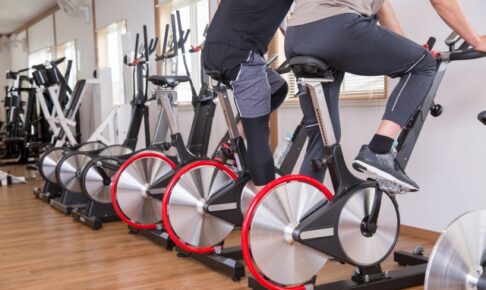



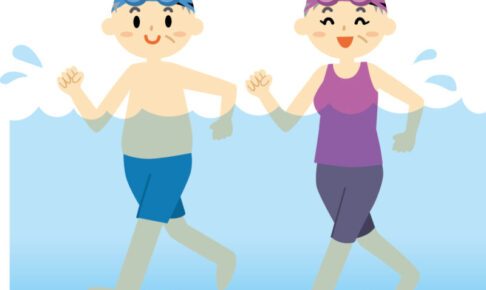

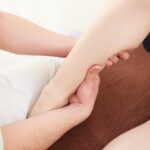
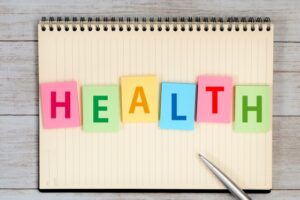
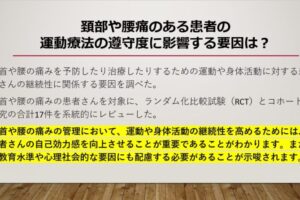
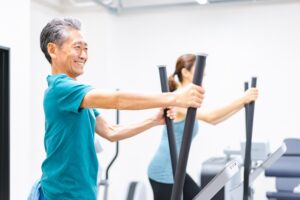
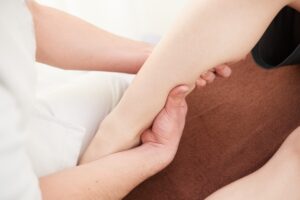
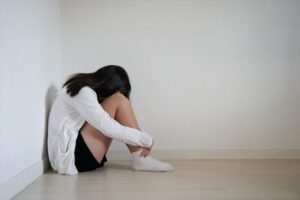
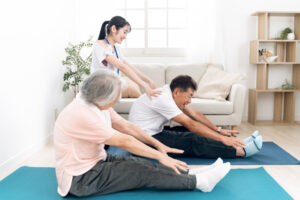
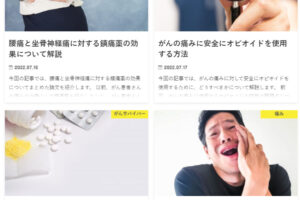
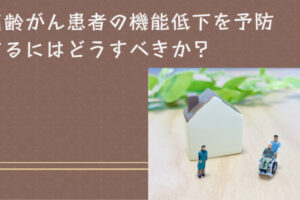









最近のコメント